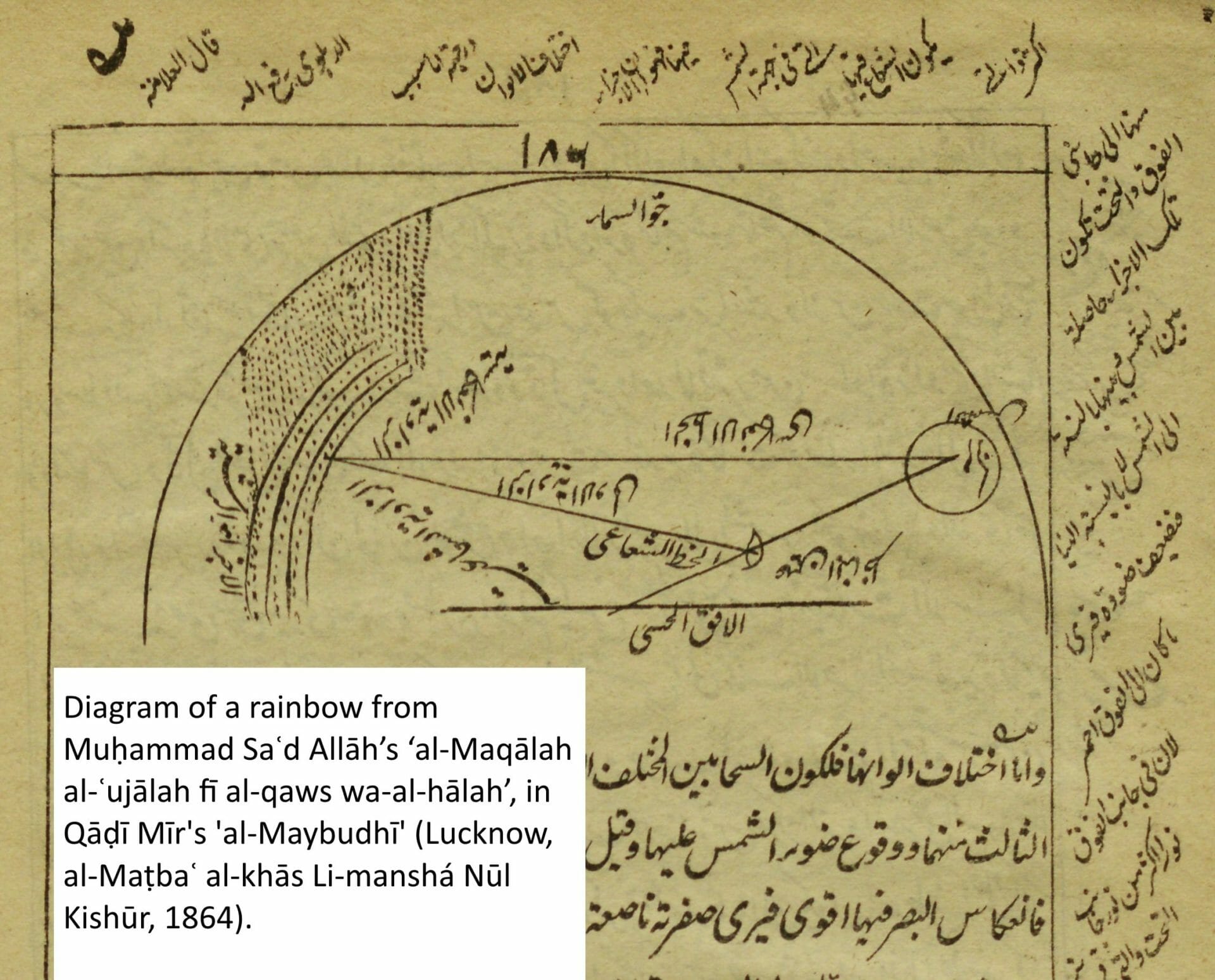Early Arabic Printed Books from the British Library continues to grow this week as we launch the next module, Sciences, History and Geography. As Editor, this module has been a particular joy to work on because of the breadth and depth of subject matter, covering everything from Alchemy to Zoology, and containing some of the very earliest printed works in Europe. Indeed, the presence of these early European printings in this module indicates the exchange of ideas between the Islamic and European worlds, and I thought I’d look to see if I could trace this exchange using the content in Sciences, History and Geography.
As Editor, this module has been a particular joy to work on because of the breadth and depth of subject matter, covering everything from Alchemy to Zoology
There are of course many subject areas on which both Arabic and European scholars wrote, but I was particularly drawn to the idea of the rainbow. Aristotle is generally accepted to be the first to consider the rainbow and its causes, and Sciences, History and Geography contains a 1495 printing of Aristotle’s ‘Physica’, in which he explains his theory as to how rainbows are formed. Aristotle understood that water and light were involved in the creation of rainbows, but he believed they were formed from the reflection of light off clouds, and he believed the rainbow was made of only three colours, reflected and inverted between two halos:

Aristotle was widely studied by Islamic scholars such as Abū ʿAlī al-Ḥusayn ibn ʿAbd Allāh ibn Al-Hasan ibn Ali ibn Sīnā (Latin: Avicenna), ʾAbū l-Walīd Muḥammad Ibn ʾAḥmad Ibn Rušd (Latin: Averroes), Abu Yūsuf Yaʻqūb ibn ʼIsḥāq aṣ-Ṣabbāḥ al-Kindī (Latin: Alkindus) and Abū Naṣr Muḥammad ibn Muḥammad Fārābī (Latin: Alpharabius), and Sciences, History and Geography contains many commentaries on Aristotle by these authors. See for instance, al-Farabi’s “Alpharabii vetustissimi Aristotelis interpretis”, or Ibn Rušd’s commentary on Aristotle’s ‘Meteorologica’, included in the 1495 printing of ‘Physica’ and from which the above diagram of a rainbow was taken.
The scholar who truly led the field in the study of light and optics was Abū ʿAlī al-Ḥasan ibn al-Ḥasan ibn al-Ḥaytham (Latin: Alhazen). Influenced by Greek philosophers such as Aristotle, his seminal work was his ‘al-Manāẓir’ or ‘Book of Optics’. Written in 11th century CE, this comprehensive study on how light travels considered the many ways in which light can be reflected and refracted, as depicted in this illustration from ‘Opticæ Thesaurus’, a 1572 translation of his work:

Al-Ḥaytham had a huge influence on both Islamic and European scholars, such as the Polish mathematician Witelo, whose works on optics are included in the 1572 printing of ‘Opticæ Thesaurus’. Below Witelo gives his own theories on the rainbow:

Al-Ḥaytham also had a particular influence on the Persian scholar Kamāl al-Dīn al-Fārisī, who would go on to prove mathematically how rainbows are formed.
Arabic scholarship on the rainbow continued into the 19th century. For example, this Arabic treatise on rainbows was published in 1864, and Ibrāhīm al-Ḥawrānī included a chapter on rainbows in his work on the wonders of nature, ‘al-Āyāt al-bayyināt fī gharāʾib al-arḍ wa-al-samawāt’:
The transfer of ideas continued to be bi-directional between East and West throughout the 19th century, as evidenced by Sulaymān ibn ʻAlī Ḥarāʼirī’s Arabic translation of French treatises on meteorology and physics.
The rainbow is just one of many scientific concepts theorised by Islamic and European scholars, and is not the only one to demonstrate the exchange of ideas. There are many ways to find more works written by or influenced by Islamic or European scholars in Sciences, History and Geography. Try searching for instance for ‘Avicenna’ or ‘Averroes’ as the LOC Subject. To find translations of Arabic works into European languages try selecting Arabic as an original language. You can then filter by subject types, authors, or place of publication. This also works vice versa – select Arabic as a language and a different language as the ‘Original Language’ to find works translated into Arabic. I hope the release of Sciences, History and Geography encourages 21st century scholars from across the globe to continue the pattern set by the likes of Ibn Sina and Al-Haytham, especially as our starting point of Aristotle once said – “in all things of nature there is something of the marvellous”.
For more information about the digital resources featured in this artice, or to request a trial, please get in touch with us today.



